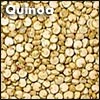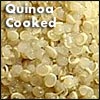All About Quinoa

Like some of the other exotic grains, Quinoa isn't a grain at all but is technically a fruit. Quinoa might be a new and exotic item here in North America, however, this isn't so in South America where it has grown for more than 5,000 years in and around the Andes Mountains. The Incas called Quinoa 'the Mother Grain' as eating this food tended to give long life. Quinoa can be grown just about anywhere - presently being grown in the US and Canada. But North American growers, so far, are unable to match the quality of Quinoa that comes from the high mountains of South America. Farmers trying to grow this variety of Quinoa, called Altiplano, haven't been able to get it to produce in the lower elevations of North America. Instead, North American farmers grow a darker brown, more bitter tasting variety of Quinoa called 'Sea Level Quinoa.' The really good, light colored, sweetly delicate Quinoa comes from the highest mountains in the Andes. This 'Golden Grain of the Andes' is such a rugged little plant that it can even grow at high, extremely dry elevations where even grass won't grow. Yet, the most sought-after strains of Quinoa are so fragile that they won't produce at lower elevations on good soil. Interestingly enough, much of the world's Quinoa is grown in Bolivia at elevations around 12,000 feet.
The Quinoa seed is a small oval disk about 1.5-2 mm in diameter. As it grows, the seed is coated with a dark, almost black layer of 'saponine' that has a bitter, soapy taste. Saponine is the plant's natural defense against insects, birds and other small animals that might want to eat it on the stock. Before Quinoa can be eaten, the saponine must me washed off. (As saponine acts as a crude soap, the locals who grow Quinoa, save the saponine-water and wash their clothes in it!) Virtually all Quinoa sold in North America as food already has the saponine removed. This leaves a very nutritious food that has been called my many, 'nature's perfect food.' Quinoa is one of the few foods with a relatively balanced protein. Quinoa's high level of the amino acid, lycine, complements wheat nicely. By mixing Quinoa into your wheat at a ratio of 25% Quinoa to 75% wheat, the Quinoa will make your wheat breads a complete protein. Quinoa contains a long list of nutrients. The following table lists the nutrients found in Quinoa that are higher than what is found in wheat:
Unit Amount % More
Of In Than
Nutrient Measure Quinoa Wheat
Food energy KCal: 374 113%
Total lipid (fat) Gms: 5.8 302%
Carbohydrate, by diff. Gms: 68.9 101%
Ttl monounsaturated fat Gms: 1.535 506%
Ttl polyunsaturated fat Gms: 2.347 306%
Riboflavin Mg : 0.396 360%
Folacin Mcg: 49 113%
Potassium Mg : 740 217%
Calcium Mg : 60 240%
Phosphorus Mg : 410 123%
Magnesium Mg : 210 169%
Iron Mg : 9.25 256%
Zinc Mg : 3.3 118%
Pantothenic acid Mg : 1.047 111%
Copper Mg : 0.82 200%
Oleic acid (18:1) Gms: 1.525 646%
Linoleic acid (18:2/n6) Gms: 2.214 304%
Lysine Gms: 0.734 181%
Methionine Gms: 0.262 113%
Arginine Gms: 0.918 130%
Tryptophan Gms: 1.100 580%
Quinoa has a high oil content of polyunsaturated fatty acids. Because of this, it's important to store Quinoa in a cool place, and if you are going to store it for the long term, place it in airtight containers and remove the oxygen with oxygen absorbers. Removing the oxygen doesn't stop the aging process of foods, but it goes a long way to extend it several times.
The Quinoa that we offer comes from the Altiplano strain grown between 12,000 and 14,000 feet in the Andes Mountains of Bolivia. It's saponine has been carefully washed off so you can still sprout the seed if you like.
Some Quinoa processors use steam during the de-saponine process which kills the seed. Our Quinoa comes directly from the subsistence farmers of the high mountains of Bolivia. Getting our Quinoa directly supports these farmers who work hard, toiling by hand without the aid of machines to plant and harvest this crop, wishing only to provide you with an outstanding product that can only be grown in this unique area of the world.
Quinoa contains no gluten so it's safe for gluten intolerant people to eat. Quinoa can be eaten in many different ways. Traditionally it has been eaten as a porridge or in soups and stews. Only taking 10-12 minutes to boil until soft (Quinoa is the fastest cooking whole grain), Quinoa seed's size mushrooms into plump little morsels with a tail. The Altiplano Quinoa has somewhat of a bland yet pleasant flavor. Having a nice, crisp texture similar to brown rice, Quinoa has greatly expanded nutritional qualities over rice and can be used in place of rice in most dishes. Quinoa is also delicious eaten as a side dish by itself. Quinoa flour has been made into spaghetti noodles, flakes, a drink and Quinoa has even been popped. Mixed with wheat flour, Quinoa will boost the nutritional qualities of your bread and add it's unique flavor. In addition to this, it can be used to make delicious salads, soups and desserts. With the amazing nutrition that's found in Quinoa, we think, as you begin to use this grain, you will start using it more and more in your daily cooking.
Recipes:
http://www.ox.compsoc.org.uk/~kake/cookery/quinoa.html
http://vegetarianrecipe.com/AZ/QinPdding.asp Quinoa pudding
http://www.quinoa.com/recipes.htm
http://www.healthrecipes.com/quinoa_recipes.htm
http://www.fatfree.com/archive/1999/oct/msg00065.html
http://www.healthrecipes.com/quinoa_recipes.htm
http://www.quinoa.net/Recipes/recipes.html
References:
http://www.quinoa.net
http://quinoa.com/quinoa.htm
http://www.nuworldamaranth.com
http://www.godsbanquet.com/recipes/grain.htm